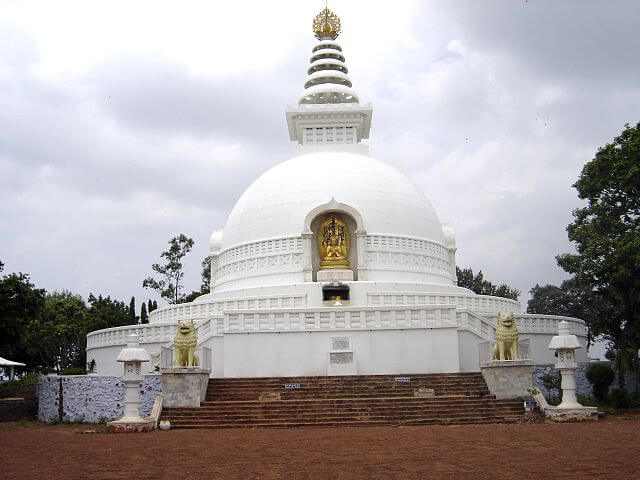Rajgir is town where the air that surrounds its beautiful sceneries carries hints of spirituality and vibrant hues of history with links with both Buddhism and Jainism.
Set in a green valley and surrounded by rocky hills, Rajgir is a spiritual town with natural serenity amongst the dense forests, mysterious caves and springs. Rajgir houses many religious destinations that are majorly dedicated to either Buddhism or Jainism. Both Lord Buddha and Lord Mahavir have said to spent time here giving it huge spiritual and religious importance. One can visit various ruins, temples and sites here and also spend some time indulging in its refreshing calmness.
Places To Visit In Rajgir
Venuvana: King Bimbisara donated the Bamboo Grove, Venuvana to Buddha for his residence. Today, it is a park with admiring sights of bamboos, flowers and a large pond with Buddha’s image in the center.
Japanese Stupa: Also known as the Vishwa Shanti Stupa, this pillar is situated atop the Gridhakuta hill at an altitude of 400m. It was built as a symbol of world peace by the Japanese.
This marble pillar also showcases four golden statues of Buddha depicting different stages of his life – birth, enlightenment, preaching and death. This location can be accessed by an aerial ropeway.
Vulture’s Peak or Griddhakuta: Another top attraction in Bihar, located in Rajgir, Vulture peak, also known as Griddhakuta is an important pilgrimage site for Buddhists. It is one of the top 3 places where Shakyamuni Buddha or the Gautama Buddha preached for many years. Located on a small hill, just outside of Rajgir, Griddhakuta is a popular sightseeing location perched at an altitude of 400 m. This peak is known as the Vulture’s Peak as it is shaped like a vulture and also provides frequent sightings of the bird. It is said to be the place where Lord Buddha resided for many years.
Rajgir Ropeway: Said to be the oldest ropeway in India, the Rajgir ropeway line is a wonderful excursion in the cradle of nature. It is the only ropeway in existence in the state of Bihar. The single person seater rope line is a thrilling adventure that leads you all the way to the top of the scenic Ratnagiri Hill which houses the famous Vishwa Shanti Stupa, also known as the Peace Pagoda. The chairlift ropeway rises to a height of over 1000 feet from the ground level and is a thrilling ride to undertake. The area falls under the Pant Wildlife Sanctuary, which provides unmatched views of the surrounding forest area. The ropeway gives access to the Buddhist memorabilia and constructions of a bygone era on the hilltop, coupled with picturesque views, there’s nothing more you can ask for!
Makhdum Kund: This place is a shrine of Makhdum Shah, a Muslim Sufi Saint. One can also visit a few warm springs here like Tapodharma.
Bimbisara’s Jail: Believed to be the place where Bimbisara was confined by his son King Ajatshatru, Bimbisara Jail offers a brilliant view of the Japanese Stupa situated on the same hill.
Veerayatan Museum: Veerayatan Museum is a fascinating Jain museum showcasing history of each of the 24 Jain Tirthankaras. It features ornate dollhouse like 3-D panel depictions made from wood and metal.
One will also see a lot of amazing arts on display here by an artist Arharya Shri who resides here and are a must watch.
Cyclopean Walls: Dating back to 2500 years ago, the Cyclopean walls are 4 meters wide and encircle the city, being 40 km long. It was built by the Mauryans with an objective to fortify the city. Today most of it stands in ruins.
Sonabhandar: Sonabhandar caves are situated on the southern slopes of the Vaibhava Hills and feature black stone statues of the first four Jain Tirthankaras and Lord Buddha.
It is believed that the treasury of King Bimbisara is still present here and the key to opening the doorway lies in the inscriptions on the walls.
Saptaparni Caves: Located on the Vaibhava Hills, Saptaparni Caves was the host to the First Buddhist Council, attended by over 500 monks and was led by Maha Kashyapa.
What is the best time to visit Rajgir?
October to March is the best time to visit Rajgir as the weather is very pleasant here. Among the festivals here, Rajgir Mahotsav is the most important one and it is celebrated each year in the month of October and is accompanied by classical performances of Indian music and dance.
How to Reach Rajgir
Patna (100 km) is the closest airport to Rajgir with connecting flights to other cities. The nearest railway station is in Rajgir, which is well connected to Patna, Kolkata and New Delhi. Rajgir is well connected by road as well with frequent buses plying to and from Patna, Bodh Gaya and other nearby towns.







